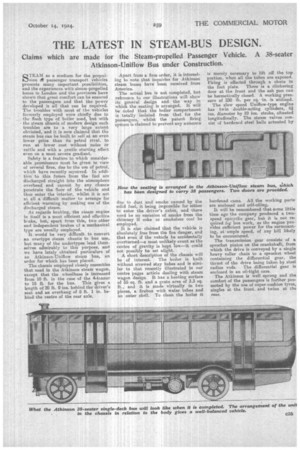THE LATEST IN STEAM-BUS DESIGN.
Page 19

If you've noticed an error in this article please click here to report it so we can fix it.
Claims whith are made for the Steam-propelled Passenger Vehicle. A 38-seater Atkinson-Uniflow Bus under Construction.
STEAM as a medium for the propulsion dif passenger transport vehicles presents many important possibilities, and the experiences with steam propelled buses in London and the provinces have shown that great comfort can be ensured to the passengers and that the power developed is all that can be required. The troubles with most of the vehicles formerly employed were chiefly due to the flash type of boiler used, but with the steam chassis of modern design such troubles are to a very large extent obviated, and it is now claimed that the steam bus can be built to sell at an even lower price than its petrol rival, to run at lower cost without noise or rattle and with a gentle starting effect even on a most severe gradient.
Safety is a feature to which considerable prominence most be given in view of several fires, due to the use of petrol, which have recently occurred. In addition to this fumes from the fuel are discharged straight into the atmosphere overhead and cannot by any chance penetrate the floor of the vehicle and thus enter the interior, whilst it is not at all a difficult matter to arrange for efficient warming by making use of the discharged steam.
As regards braking, the steam engine in itself is a most efficient and effective brake, but, apart from this, two other and independent brakes a a mechanical type are usually employed.
It would be very difficult to convert an overtype steam chassis to bus use, but many of the undertypes lend themselves admirably to this purpose, and we have lately obtained particulars of an Atkinson-Uniflow steam bus, an order for which has been placed.
The chassis employed closely resembles that used in the Atkinson steam wagon, except that the wheelbase is increased from 10 ft in the case of the 4-tonner to 15 ft. for the bus. This gives a length of 20 ft. 9 ins, behind the driver's seat and an overhang of 8 ft. 1 in. behind the centre of the rear axle.
Apart from a firm order, it is interesting to note that inquiries for Atkinson steam buses have been received from America.
The actual bus is not completed, but reference to our illustrations will show its general design and the way in which the seating is arranged. It will be noted that the boiler compartment is totally isolated from that for the passengers, whilst the patent firing system is claimed to prevent any nuisance due to dust and smoke caused by the solid fuel, it being impossible for either to enter the driver's cabin, and there need be no emission of smoke from the chimney if coke or smokeless coal be employed.
It is also claimed that the vehicle is absolutely free from the fire danger, and that even if the vehicle be accidentally overturned—a most unlikely event as the centre of gravity is kept low—it could not possibly be set alight.
A short description of the chassis will
be of interest. The boiler is built without screwed stay tubes and is similar to that recently illustrated in our centre pages article dealing with steam wagon design It has a heating surface of 55 sq. ft. and a grate area of 3.3 sq. IL, and it is made virtually in two pieces, a firebox with water tubes and an outer shell. To clean the boiler it
is merely necessary to lift off the top portion, when all the tubes are exposed. Firing is effected through a chute in the foot plate. There is a clinkering door at the front and the ash pan can be hermetically closed. A working pressure of 2.30 lb. per sq. in. is utilized. The slow speed Uniflow-type engine has twin double-acting cylinders, 61 ins, diameter by 10 ins, stroke, situated longitudinally. The steam valves consist of hardened steel balls actuated by hardened cams. All the working parts are enclosed and self-oiling.
It will be remembered that some little time ago the company produced a twospeed epicyclic gear, but it is not required fo,r bus work, as the engine provides sufficient power for the surmounting, at ample speed, of any hill likely to be encountered.
The transmission gear consists of a sprocket pinion on the crankshaft, from which the drive is conveyed by a single heavy roller chain to a sprocket wheel containing the differential gear, the thrust of the drive being taken by steel
radius rods. The differential gear is enclosed in an oil-tight case. The Atkinson is well sprung and the comfort of the passengers is further promoted by the use of super-cushion tyres, singles at the front and twins at the rear.






























